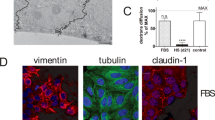Summary
The rat hepatoma cell line, H4-II-E, was grown serially over a I-year period and about 30 passages in arginine-, glutamine-, and tyrosine-deprived and ornithine-supplemented Eagle's mininum essential medium with no supplements other than biotin. The adapted cel line, R-Y121B, proliferates in the above mentioned medium with a doubling time of about 4 days and maintains hepatic “marker” enzymes such as tyrosine aminotransferase, phenylalanine hydroxylase, and all the enzymes of the urea cycle.
Similar content being viewed by others
References
Niwa, A.: Yamamoto, K.; Yasumura, Y. Establishment of a rat hepatoma cell line which has ornithine carbamoyltransferase activity and grows continuously in arginine-deprived medium. J. Cell. Physiol. 98: 177–184; 1979.
Yasumura, Y.; Niwa, A.; Yamamoto, K. Phenotypic requirement for glutamine of kidney cells and for glutamine and arginine of liver cells in culture. Katsuta, H. ed. Nutritional requirements of cultured cells. Tokyo: Japan Scientific Societies Press; and Baltimore: University Park Press; 1978: 223–255.
Pitot, H. C.; Peraino, C.; Morse, P. A Jr.; Potter, V. R. Hepatomas in tissue culture compared with adapting liverin vivo. Natl. Cancer Inst. Monogr. 13: 229–245; 1964.
Eagle, H. Amino acid metabolism in mammalian cell cultures. Science 130: 432–437; 1959.
Piez, K. A.; Oyama V. I.; Levintow, L.; Eagle, H. Proteolysis in stored serum and its possible significance in cell culture. Nature 188: 59–60; 1960.
Hayflick, L. Tissue cultures and mycoplasmas. Tex. Rep. Biol. Med., Suppl. 1 23: 285–303; 1965.
Barile, M. F.; Schimke, R. T. A rapid chemical method for detecting PPLO contamination of tissue cell culture. Proc. Soc. Exp. Biol. Med. 114: 676–679; 1963.
Lowry, O. H.; Rosebrough, N. J.; Farr, A. L.; Randall, R. J. Protein measurement with the Folin phenol reagent. J. Biol. Chem. 193: 265–275; 1951.
Schimke, R. T. Adaptive characteristics of urea cycle enzymes in the rat. J. Biol. Chem. 237: 459–468; 1962.
Granner, D. K.; Tomkins, G. M. Tyrosine aminotransferase (rat liver). Tabor, H.; Tabor, C. W. eds. Methods in enzymology. vol 17A New York: Academic Press; 1970: 633–637.
Miller, M. R.; McClure, D.; Shiman, R.p-Chlorophenylalanine effect on phenylalanine hydroxylase in hepatoma cells in culture. J. Biol. Chem 250: 1132–1140; 1975.
Haggerty, D. F.; Young P. L.; Popják, G.; Carnes, W. H. Phenylalanine hydroxylase in cultured hepatocytes. I. Hormonal control of enzyme levels. J. Biol. Chem. 248: 223–232;1973.
Rose, W. C. The nutritive significance of the amino acids. Physiol. Rev. 18: 109–136; 1938.
Eagle, H; Oyama, V. I.; Levy, M.; Horton C. L.; Fleischman, R. The growth response of mammalian cells in tissue culture tol-glutamine andl-glutamic acid. J. Biol. Chem. 218: 607–616; 1956.
Eagle, H.; Washington, C. L.; Levy, M.; Cohen, L. The population-dependent requirement by cultured mammalian cells for metabolites which they can synthesize. II. Glutamic acid and glutamine; aspartic acid and asparagine. J. Biol. Chem. 241: 4994–4999; 1966.
Katsuta, H. Takaoka, T.; Hosaka, S.; Hibino, M.; Otsuki, I.; Hattori, K.; Suzuki, S.; Mitamura, K. Protein requirements of rat ascites hepatoma cells in tissue culture. Jpn. J. Exp. Med. 29: 45–70; 1959.
Puck, T. T. The mammalian cell as a microorganism. Genetic and biochemical studies in vitro. San Francisco: Holden-Day; 1972; 14–19.
Gerschenson, L. E.; Okigaki, T.; Andersson, M.; Molson, J.; Davidson, M. B. Fine structural and growth characteristics of cultured rat liver cells. Insulin effects. Exp. Cell Res. 71: 49–58; 1972.
Author information
Authors and Affiliations
Additional information
This work was supported in part by Grant-in-Aid for Cancer Research 301050 and Science Research Grant 337013 from the Ministry of Education, Science and Culture, Japan.
Rights and permissions
About this article
Cite this article
Niwa, A., Yamamoto, K., Sorimachi, K. et al. Continuous culture of reuber hepatoma cells in serum-free, arginine-, glutamine-and tyrosine-deprived chemically defined medium. In Vitro 16, 987–993 (1980). https://doi.org/10.1007/BF02619337
Received:
Accepted:
Issue Date:
DOI: https://doi.org/10.1007/BF02619337




